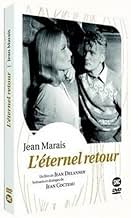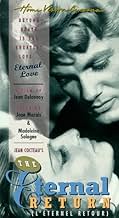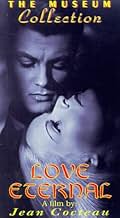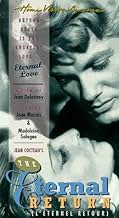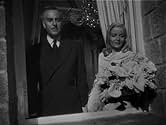CALIFICACIÓN DE IMDb
7.2/10
664
TU CALIFICACIÓN
Agrega una trama en tu idiomaThis is a retelling of Tristan and Isolde, set in 1940s France. The script was written by Jean Cocteau.This is a retelling of Tristan and Isolde, set in 1940s France. The script was written by Jean Cocteau.This is a retelling of Tristan and Isolde, set in 1940s France. The script was written by Jean Cocteau.
Opiniones destacadas
10Draecke
A spectacular and beautiful film, and perhaps one of the best movies ever made. In the roles of an updated Tristan and Isolde, Sologne and Marais are a stunningly handsome couple. This powerful romantic tragedy transcends the ephemeral world of politics altogether and carries us into the realm of dreams & legend, as "Beauty & the Beast" did so well. Its theme and sense of style actually have much in common with many German films of its time. Admirers of the art of Jean Cocteau will not be disappointed.
10QwikBall
I thought this film was genius. For this implicit portrayal of Nazi politics to be made in Vichy France is astounding. The sinister Achille is one of the most shockingly real characters I've ever seen. If you speak French, see this movie (do NOT rely on the subtitling...it's shoddy).
This movie was written by Jean Cocteau and it's pretty obvious due to the odd plot twists, romantic tone and mythological roots to the plot. Just a few years later, he was to BOTH write and direct Beauty and the Beast and Orpheus. These two are better films than The Eternal Return, though this movie is still worth watching--particularly as it shows and evolution of Cocteau's ideas. So, this movie is sort of like and unpolished version of these two later movies in many ways--particularly Orpheus. Absent from this film are the odd camera tricks but the story elements are all here.
The love between the two main characters is best described as a combination of the tragic stories of Orpheus and Eurydice along with Romeo and Juliet, but I have recently been informed that the story is ACTUALLY a reworking of the story of Tristan and Isolde. Thrown in for good measure are a malevolent dwarf, the dwarf's detestable parents and a lot of cool plot twists.
However, there were a few things that just didn't work out well in the movie. First, when it was obvious that the crazed dwarf had tried to kill the lovers by offering them what he thought was poison, nothing was done to punish him or place him in an institute for the criminally insane. This is pretty prudent considering what the dwarf does LATER in the story! Second, I hate movies that feature ladies fainting. Unless there is a blow to the head or they've gone without eating for a very extended period of time, people DON'T just faint. This is such a stupid cliché and I'm a little surprised that anyone as innovative and intelligent as Cocteau would resort to this device.
Other than that, it's a nice film.
FYI--An IMPORTANT warning: The video I watched was from The International Collection from Nelson Entertainment. If there are any OTHER companies that make this video, try them first!!!! The captioning was absolutely horrible!! Often, much of the dialog was not subtitled or very long statements were boiled down to one or two words!!! They showed very little respect for the integrity of the movie!
The love between the two main characters is best described as a combination of the tragic stories of Orpheus and Eurydice along with Romeo and Juliet, but I have recently been informed that the story is ACTUALLY a reworking of the story of Tristan and Isolde. Thrown in for good measure are a malevolent dwarf, the dwarf's detestable parents and a lot of cool plot twists.
However, there were a few things that just didn't work out well in the movie. First, when it was obvious that the crazed dwarf had tried to kill the lovers by offering them what he thought was poison, nothing was done to punish him or place him in an institute for the criminally insane. This is pretty prudent considering what the dwarf does LATER in the story! Second, I hate movies that feature ladies fainting. Unless there is a blow to the head or they've gone without eating for a very extended period of time, people DON'T just faint. This is such a stupid cliché and I'm a little surprised that anyone as innovative and intelligent as Cocteau would resort to this device.
Other than that, it's a nice film.
FYI--An IMPORTANT warning: The video I watched was from The International Collection from Nelson Entertainment. If there are any OTHER companies that make this video, try them first!!!! The captioning was absolutely horrible!! Often, much of the dialog was not subtitled or very long statements were boiled down to one or two words!!! They showed very little respect for the integrity of the movie!
I see the Nazi references, but there are subtle subliminal messages being sent to the French people who were under the jackboot of Nazi oppression. It was not a proud time for them. Remember that during the Middle Ages, Vikings invaded France from the North. The men from the North who became the Normans finally assimilated nicely with the people living in northern France. Men who were expert sailors learned farming and the language of the "French". Re-telling the Tristan story always seemed to me to be a way to reach the soul of the French. It's a way to remind them of the time of the brave knight who comes to the rescue of his lady. The blondness of Patrice and Nathalie could be a reference to the Normans. They are both orphans of the sea and the death scene with both of them positioned perfectly on a boat(linked eternally)with the skies parting to bring them up to heaven is very reminiscent of the French epic poem "Chanson de Roland". It also reminds me of a dead Viking warrior being cast out to sea on his burning boat. A film to be enjoyed on many levels and a way to appease the Aryan loving Nazis while resonating with the proud history of the French.
Director Jean Delannoy had intended making the legend of Tristram and Yseult as an historical film but budgetary constraints obliged him to film it in modern dress. Enter poet Jean Cocteau who envisaged this as a vehicle for his 'protegé' Jean Marais.
Taking its title from Nietzsche's 'Thus Spake Zarathustra', Cocteau has imbued his screenplay with what he called 'the marvellous' which he defined as 'that which removes us from the confines within which we have to live.' This of course was manna from heaven for those living under German occupation. Such escapist fare was adored by the public although the critics in their infinite wisdom were less enthusiastic and regarded it as too 'Aryan'. In Britain it was dismissed as 'Teutonic mysticism' and Monsieur Marais described as a cross between Lohengrin and Horst Wessel!
Almost eighty years on however it remains one of the most poetic and beautiful of films. Delannoy is truly blessed to have the services of production designer Georges Wahkévitch, cinematographer Roger Hubert and composer Georges Auric.
Jean Marais' athletic physique and chiselled features make him perfect casting as Patrice and he is complemented by the cool and mysterious Madeleine Solange as Nathalie la blonde. Ironically it was Mlle Solange's perceived chumminess with the Vichy regime that was to damage her career.
Delannoy has drawn splendid performances from Jean Murat, Junie Astor, Yvonne de Bray, Roland Toutain, Jeanne Marken and Alexandre Rignault whilst Périel is unforgettable as the destructive dwarf. The presence of canine chum Moulouk is inspired.
The final apotheosis of the doomed lovers is one of the most memorable scenes on film and cannot fail to move all but the hardest hearted.
Taking its title from Nietzsche's 'Thus Spake Zarathustra', Cocteau has imbued his screenplay with what he called 'the marvellous' which he defined as 'that which removes us from the confines within which we have to live.' This of course was manna from heaven for those living under German occupation. Such escapist fare was adored by the public although the critics in their infinite wisdom were less enthusiastic and regarded it as too 'Aryan'. In Britain it was dismissed as 'Teutonic mysticism' and Monsieur Marais described as a cross between Lohengrin and Horst Wessel!
Almost eighty years on however it remains one of the most poetic and beautiful of films. Delannoy is truly blessed to have the services of production designer Georges Wahkévitch, cinematographer Roger Hubert and composer Georges Auric.
Jean Marais' athletic physique and chiselled features make him perfect casting as Patrice and he is complemented by the cool and mysterious Madeleine Solange as Nathalie la blonde. Ironically it was Mlle Solange's perceived chumminess with the Vichy regime that was to damage her career.
Delannoy has drawn splendid performances from Jean Murat, Junie Astor, Yvonne de Bray, Roland Toutain, Jeanne Marken and Alexandre Rignault whilst Périel is unforgettable as the destructive dwarf. The presence of canine chum Moulouk is inspired.
The final apotheosis of the doomed lovers is one of the most memorable scenes on film and cannot fail to move all but the hardest hearted.
¿Sabías que…?
- TriviaParis box office: 10,511,384 French francs (11-1-1944).
- Versiones alternativasThere is an Italian edition of this film on DVD, distributed by DNA Srl: "LES DAMES DU BOIS DE BOULOGNE (Perfidia, 1945) + L'ÉTERNEL RETOUR (L'immortale leggenda, 1943)" (2 Films on a single DVD), re-edited with the contribution of film historian Riccardo Cusin. This version is also available for streaming on some platforms.
- ConexionesFeatured in Pink Ulysses (1990)
Selecciones populares
Inicia sesión para calificar y agrega a la lista de videos para obtener recomendaciones personalizadas
Detalles
- Tiempo de ejecución1 hora 47 minutos
- Color
- Relación de aspecto
- 1.37 : 1
Contribuir a esta página
Sugiere una edición o agrega el contenido que falta

Principales brechas de datos
By what name was Eterna historia (1943) officially released in India in English?
Responda
